On-State Voltage Measurement Circuit for Condition Monitoring of MOSFETs in Resonant Converters
Abstract
:1. Introduction
2. MOSFET Junction Temperature Characterization
- MD diode forward voltage vs. temperature,
- DUT body diode forward voltage vs. temperature,
- JEDEC 51-14 transient method on DUT,
- DUT RDS,on characterization vs. temperature.
2.1. MD Diode Characterization
2.2. DUT Body Diode Characterization and JEDEC 51-1
2.3. DUT VDS,on Characterization
3. Evaluation of the On-State Resistance Used for Junction Temperature Estimation
3.1. On-Voltage Measurement Circuit
3.2. LLC Converter
- Input voltage: 400 V ± 1%
- Maximum output power: 1500 W
- Output voltage: 48 V ± 1%
- Maximum output current: 31.25 A
- Efficiency (at maximum load): ≥95%
- Resonant frequency: 102.73 kHz
3.3. OVMC Compensation in LLC Converter
4. Condition Monitoring of the Resonant Converter by Combining the MOSFET Junction Temperature Characterization and OVMC
5. Conclusions
Author Contributions
Funding
Data Availability Statement
Conflicts of Interest
References
- Kumar, A.; Moradpour, M.; Losito, M.; Franke, W.-T.; Ramasamy, S.; Baccoli, R.; Gatto, G. Wide Band Gap Devices and Their Application in Power Electronics. Energies 2022, 15, 9172. [Google Scholar] [CrossRef]
- Rizzo, S.A.; Salerno, N. Actual reasons involving turn-off losses improvement with increasing load and gate resistance in MOSFETs enhanced with Kelvin source. IEEE Trans. Ind. Electron. 2024, 71, 369–379. [Google Scholar] [CrossRef]
- Roccaforte, F.; Fiorenza, P.; Greco, G.; Nigro, R.L.; Giannazzo, F.; Iucolano, F.; Saggio, M. Emerging trends in wide band gap semiconductors (SiC and GaN) technology for power devices. Microelectron. Eng. 2018, 187–188, 66–77. [Google Scholar] [CrossRef]
- Adragna, C. LLC Resonant Converters: An Overview of Modeling, Control and Design Methods and Challenges. Found. Trends® Electr. Energy Syst. 2022, 5, 75–491. [Google Scholar] [CrossRef]
- Nguyen, M.H.; Kwak, S. Enhance Reliability of Semiconductor Devices in Power Converters. Electronics 2020, 9, 2068. [Google Scholar] [CrossRef]
- Martínez, J.; Riba, J.-R.; Moreno-Eguilaz, M. State of Health Prediction of Power Connectors by Analyzing the Degradation Trajectory of the Electrical Resistance. Electronics 2021, 10, 1409. [Google Scholar] [CrossRef]
- Rizzo, S.A.; Susinni, G.; Iannuzzo, F. Intrusiveness of Power Device Condition Monitoring Methods: Introducing Figures of Merit for Condition Monitoring. IEEE Ind. Electron. Mag. 2022, 16, 60–69. [Google Scholar] [CrossRef]
- Bayerer, R.; Herrmann, T.; Licht, T.; Lutz, J.; Feller, M. Model for Power Cycling lifetime of IGBT Modules—Various factors influencing lifetime. In Proceedings of the 5th International Conference on Integrated Power Electronics Systems, Nuremberg, Germany, 11–13 March 2008; pp. 1–6. [Google Scholar]
- Junghaenel, M.; Schmidt, R.; Strobel, J.; Scheuermann, U. Investigation on Isolated Failure Mechanisms in Active Power Cycle Testing. In Proceedings of the PCIM Europe 2015; International Exhibition and Conference for Power Electronics, Intelligent Motion, Renewable Energy and Energy Management, Nuremberg, Germany, 19–20 May 2015; pp. 1–8. [Google Scholar]
- Duan, Y.; Kang, J.; Shi, Y.; Xin, Z. An Online On-State Voltage Measurement Circuit With Series Diode Clamp for SiC MOSFETs. CPSS Trans. Power Electron. Appl. 2023, 8, 23–32. [Google Scholar] [CrossRef]
- Baker, N.; Luo, H.; Iannuzzo, F. Simultaneous On-State Voltage and Bond-Wire Resistance Monitoring of Silicon Carbide MOSFETs. Energies 2017, 10, 384. [Google Scholar] [CrossRef]
- Hosseinabadi, F.; Jaman, S.; Bhoi, S.K.; Hasan, M.M.; Chakraborty, S.; El Baghdadi, M.; Hegazy, O. Implementation of onsite Junction Temperature Estimation for a SiC MOSFET Module for Condition Monitoring. In Proceedings of the 2022 24th European Conference on Power Electronics and Applications (EPE’22 ECCE Europe), Hanover, Germany, 5–9 September 2022; pp. P.1–P.6. [Google Scholar]
- Hong, K.; Chen, X.Y.; Chen, Y.; Zhang, M.S.; Wang, J.L.; Jiang, S.; Pang, Z.; Yang, H.M.; Xue, N.; Gou, H.Y.; et al. Experimental Investigations Into Temperature and Current Dependent On-State Resistance Behaviors of 1.2 kV SiC MOSFETs. IEEE J. Electron Devices Soc. 2019, 7, 925–930. [Google Scholar] [CrossRef]
- Zhang, Q.; Zhang, P. A Novel Model of the Aging Effect on the ON-State Resistance of SiC Power MOSFETs for High-Accuracy Package-Related Aging Evaluation. IEEE Trans. Ind. Electron. 2023, 70, 9495–9504. [Google Scholar] [CrossRef]
- Zhang, Q.; Yang, Y.; Zhang, P. A Novel Method for Monitoring the Junction Temperature of SiC MOSFET On-line Based on On-state Resistance. In Proceedings of the 2019 22nd International Conference on Electrical Machines and Systems (ICEMS), Harbin, China, 11–14 August 2019; pp. 1–5. [Google Scholar]
- Ye, Z.; Zheng, Z.; Li, C. A New Measurement of Online Junction Temperature Based on On-state Resistance. In Proceedings of the 2023 IEEE 6th International Electrical and Energy Conference (CIEEC), Hefei, China, 12–14 May 2023; pp. 3367–3370. [Google Scholar]
- Stella, F.; Pellegrino, G.; Armando, E.; Daprà, D. Online Junction Temperature Estimation of SiC Power MOSFETS through On-State Voltage Mapping. IEEE Trans. Ind. Appl. 2018, 54, 3453–3462. [Google Scholar] [CrossRef]
- Magnone, P.; Petucco, A.; Thevenet, N.; Abedini, H. Simplified on-line monitoring system of MOSFET on-resistance based on a semi-empirical model. In Proceedings of the 2019 IEEE Applied Power Electronics Conference and Exposition (APEC), Anaheim, CA, USA, 17–21 March 2019; pp. 2746–2750. [Google Scholar]
- Sirat, A.P.; Roy, C.; Evans, D.; Gafford, J.; Parkhideh, B. In-Situ Ultrafast Sensing Techniques for Prognostics and Protection of SiC Devices. In Proceedings of the 2022 IEEE 9th Workshop on Wide Bandgap Power Devices & Applications (WiPDA), Redondo Beach, CA, USA, 7–9 November 2022; pp. 142–147. [Google Scholar]
- Roy, C.; Kim, N.; Evans, D.; Sirat, A.P.; Gafford, J.; Parkhideh, B. A Half-Bridge On-State Voltage Sensor for In-Situ Measurements. In Proceedings of the 2022 IEEE Energy Conversion Congress and Exposition (ECCE), Detroit, MI, USA, 9–13 October 2022; pp. 1–7. [Google Scholar]
- Roy, C.; Kim, N.; Gafford, J.; Parkhideh, B. On-State Voltage Measurement of High-Side Power Transistors in Three-Phase Four-Leg Inverter for In-Situ Prognostics. In Proceedings of the 2021 IEEE Energy Conversion Congress and Exposition (ECCE), Vancouver, BC, Canada, 10–14 October 2021; pp. 2770–2776. [Google Scholar]
- Scuto, A.; Sorrentino, G.; Ventimiglia, M.; Belverde, G.; Nardo, D.; Vitale, G.; Lullo, G. Assessment of MOSFET switching losses in an LLC converter by a calorimetric method. In Proceedings of the 2023 IEEE Applied Power Electronics Conference and Exposition (APEC), Orlando, FL, USA, 19–23 March 2023; pp. 2456–2462. [Google Scholar]
- Zhang, Q.; Lu, G.; Yang, Y.; Zhang, P. A High-Frequency Online Junction Temperature Monitoring Method for SiC mosfets Based on on-State Resistance With Aging Compensation. IEEE Trans. Ind. Electron. 2023, 70, 7393–7405. [Google Scholar] [CrossRef]
- B1506A Power Device Analyzer/Curve Tracer for Circuit Design. Available online: https://www.keysight.com/dk/en/product/B1506A/power-device-analyzer-curve-tracer-circuit-design.html (accessed on 17 September 2024).
- Barón, K.M.; Weiser, M.C.J.; Sharma, K.; Kallfass, I. Analysis of a Transistor-Based On-State Voltage Measurement Circuit for Condition Monitoring of Power Transistors. In Proceedings of the 2023 IEEE Applied Power Electronics Conference and Exposition (APEC), Orlando, FL, USA, 19–23 March 2023; pp. 2556–2562. [Google Scholar]
- Gelagaev, R.; Jacqmaer, P.; Driesen, J. A Fast Voltage Clamp Circuit for the Accurate Measurement of the Dynamic ON-Resistance of Power Transistors. IEEE Trans. Ind. Electron. 2015, 62, 1241–1250. [Google Scholar] [CrossRef]
- Weiser, M.C.J.; Barón, K.M.; Fink, T.; Kallfass, I. A Fast ON-State Drain-to-Source Voltage Amplifier for the Dynamic Characterization of GaN Power Transistors. In Proceedings of the 2023 IEEE Applied Power Electronics Conference and Exposition (APEC), Orlando, FL, USA, 19–23 March 2023; pp. 637–644. [Google Scholar]
- Rossetto, L.; Spiazzi, G. A Fast ON-State Voltage Measurement Circuit for Power Devices Characterization. IEEE Trans. Power Electron. 2022, 37, 4926–4930. [Google Scholar] [CrossRef]
- Guacci, M.; Bortis, D.; Kolar, J.W. On-state voltage measurement of fast switching power semiconductors. CPSS Trans. Power Electron. Appl. 2018, 3, 163–176. [Google Scholar] [CrossRef]
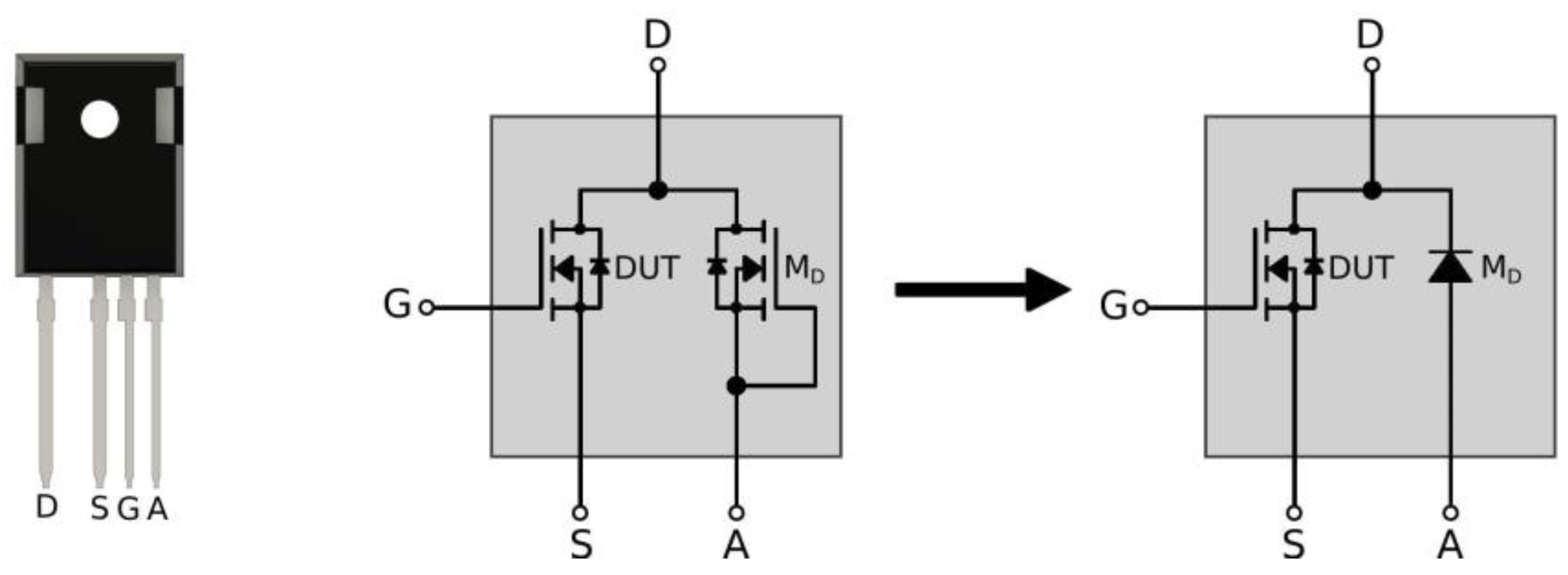




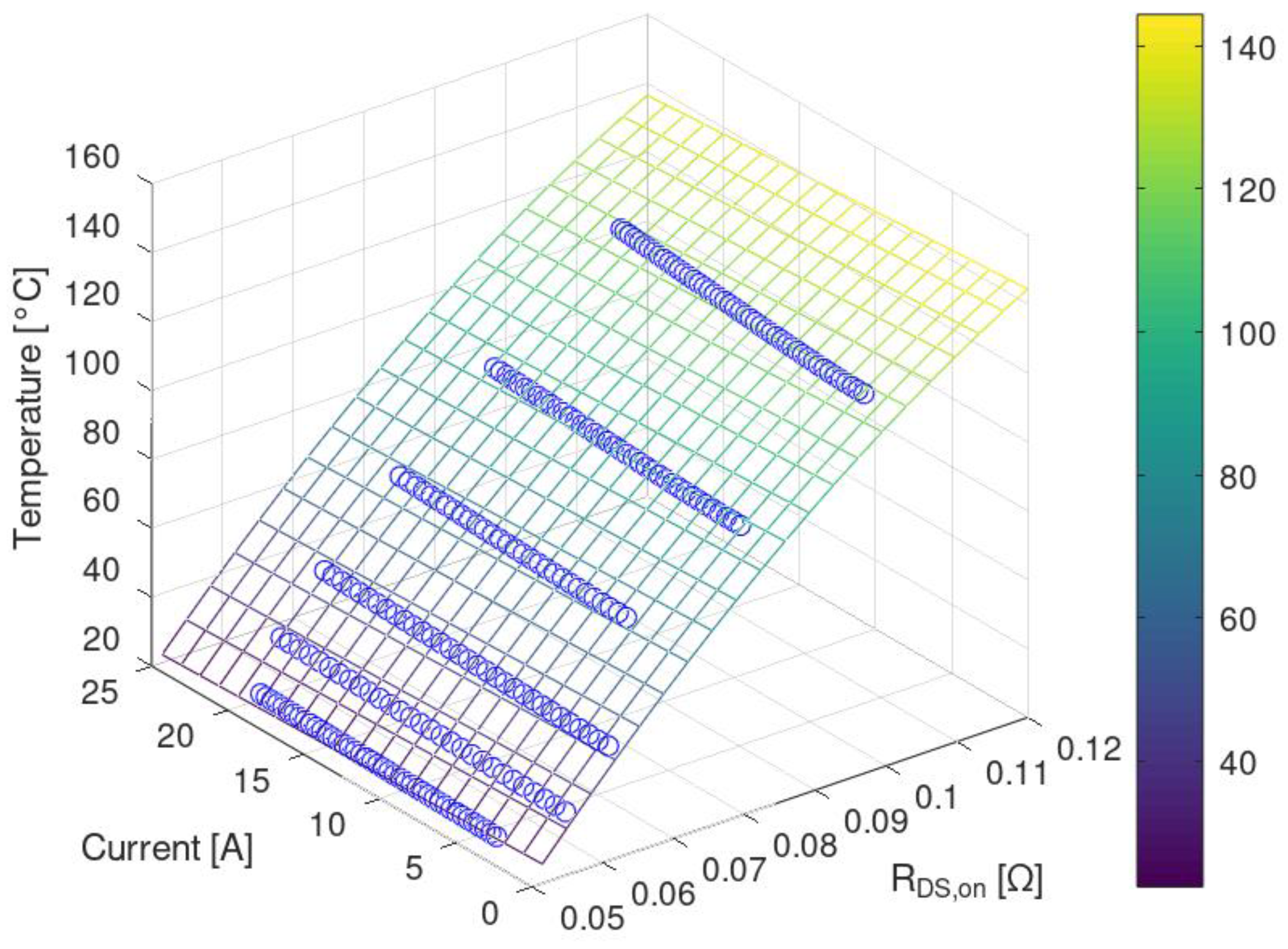
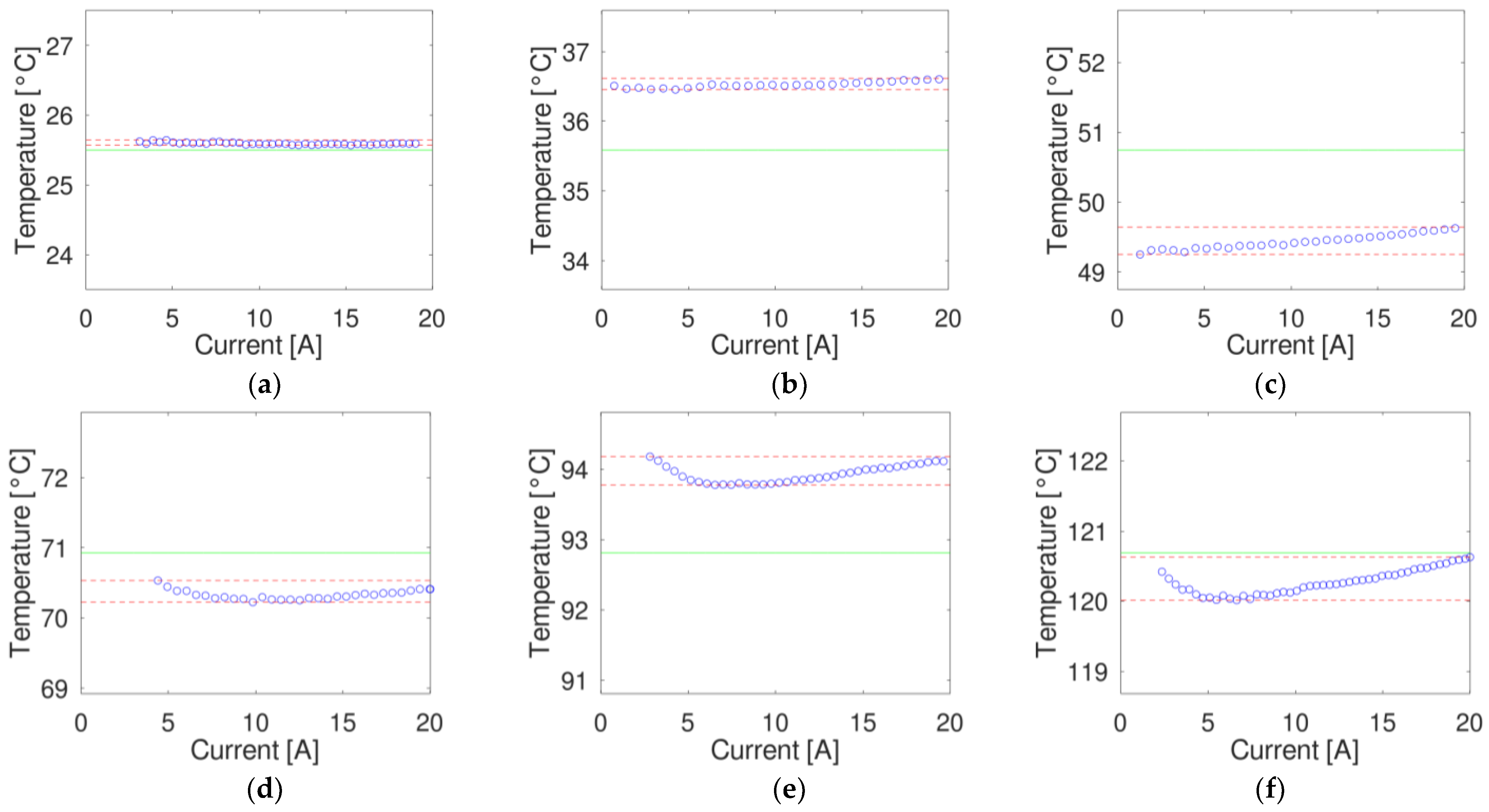
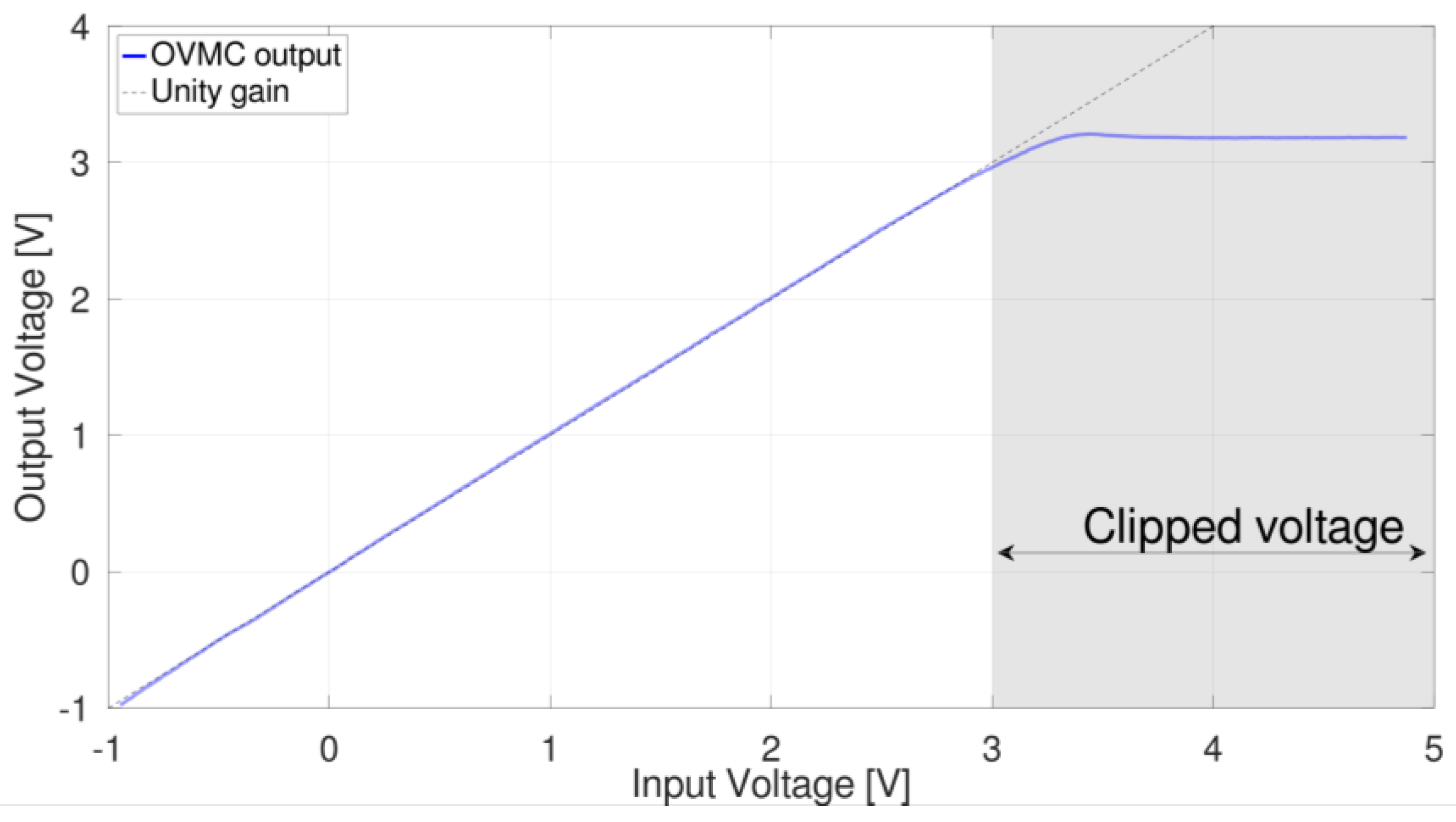



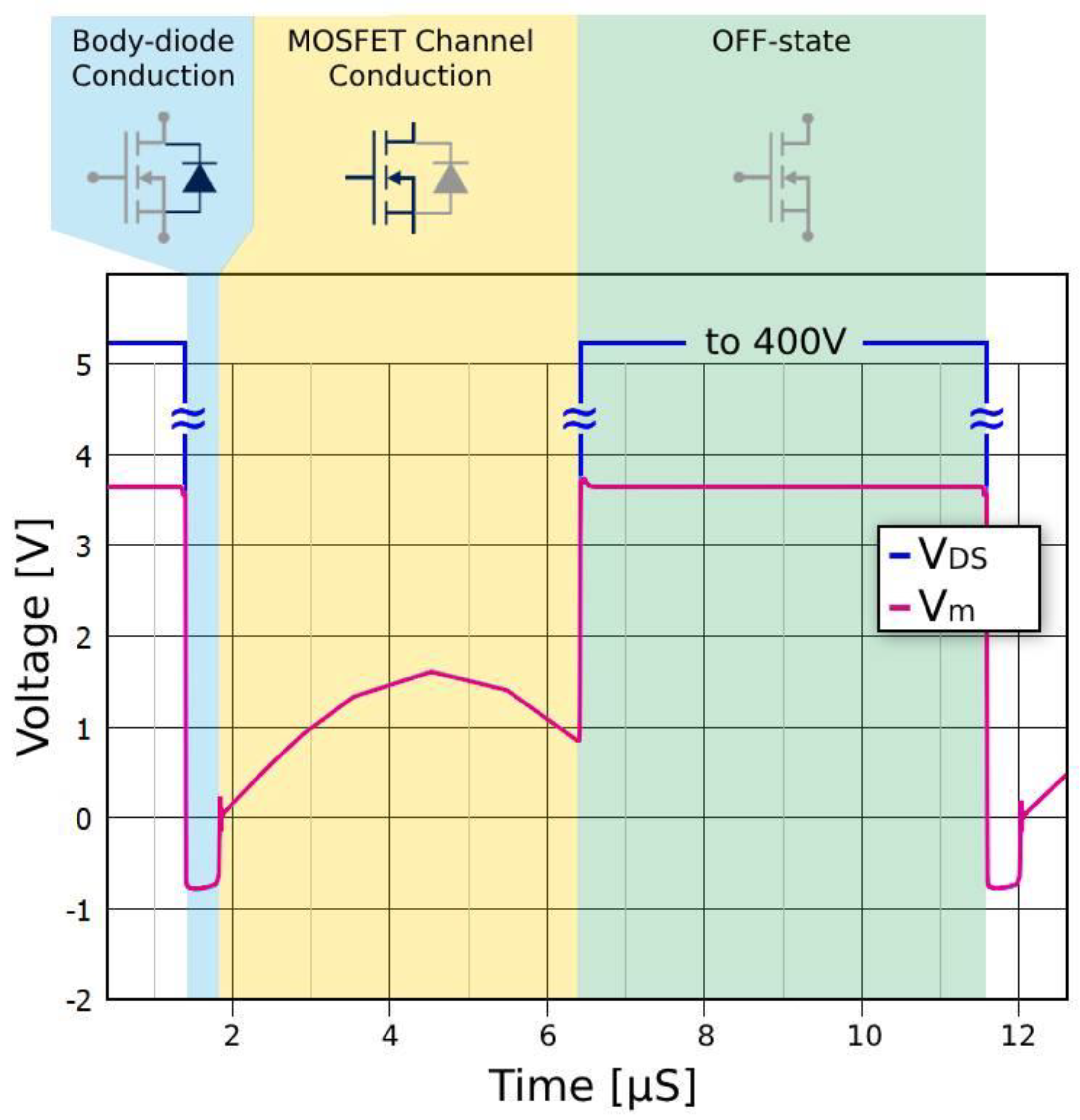
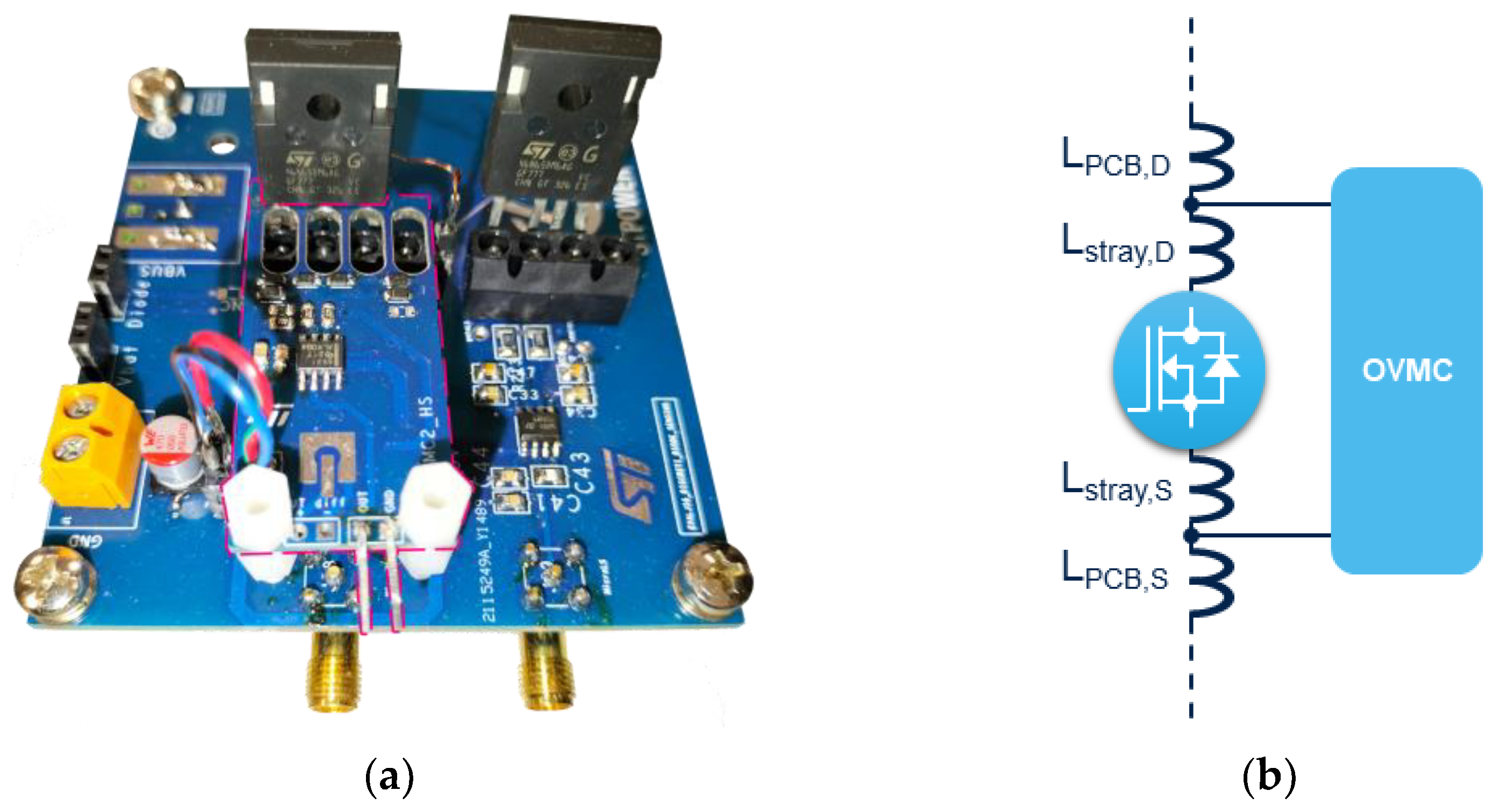


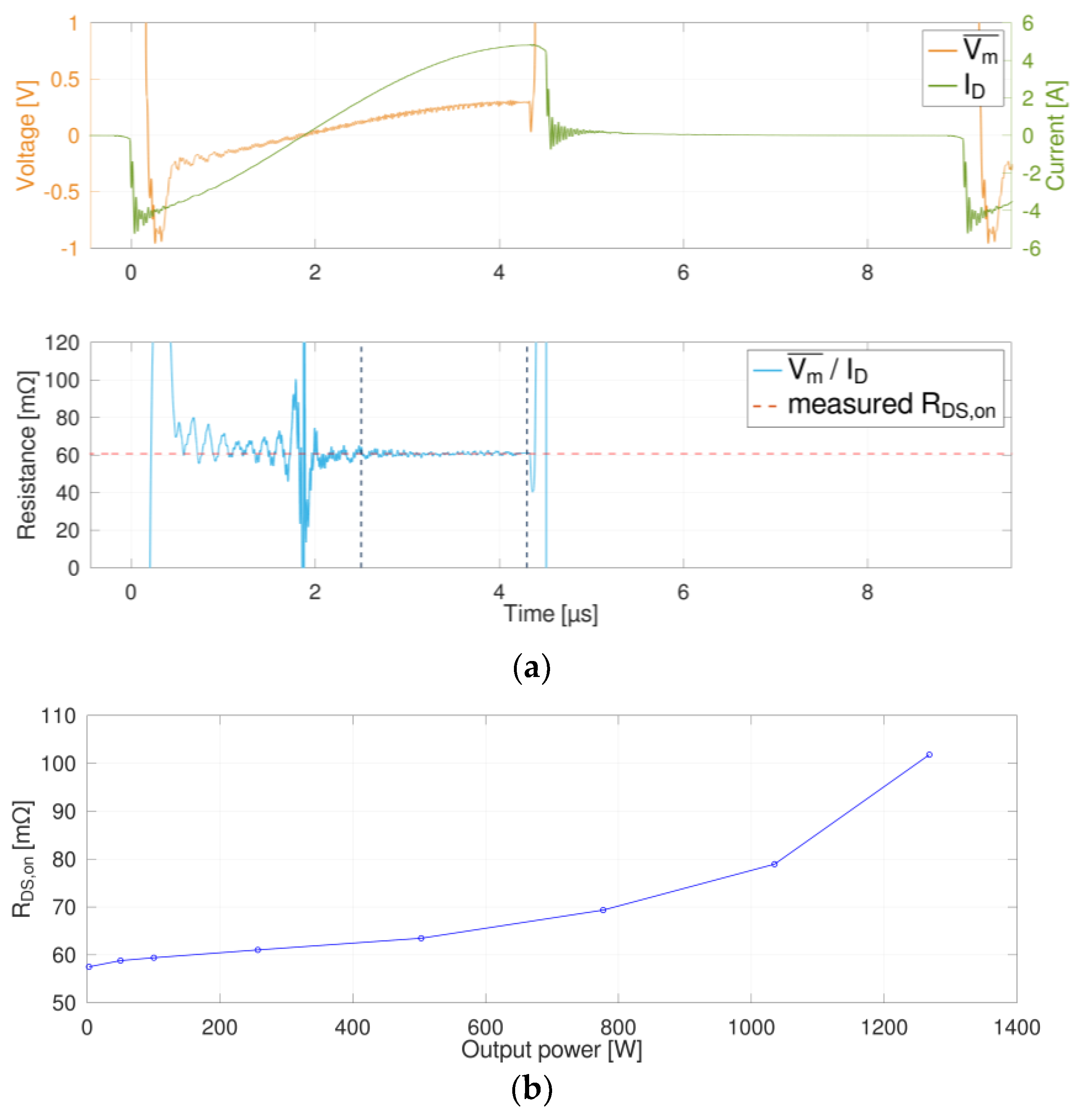

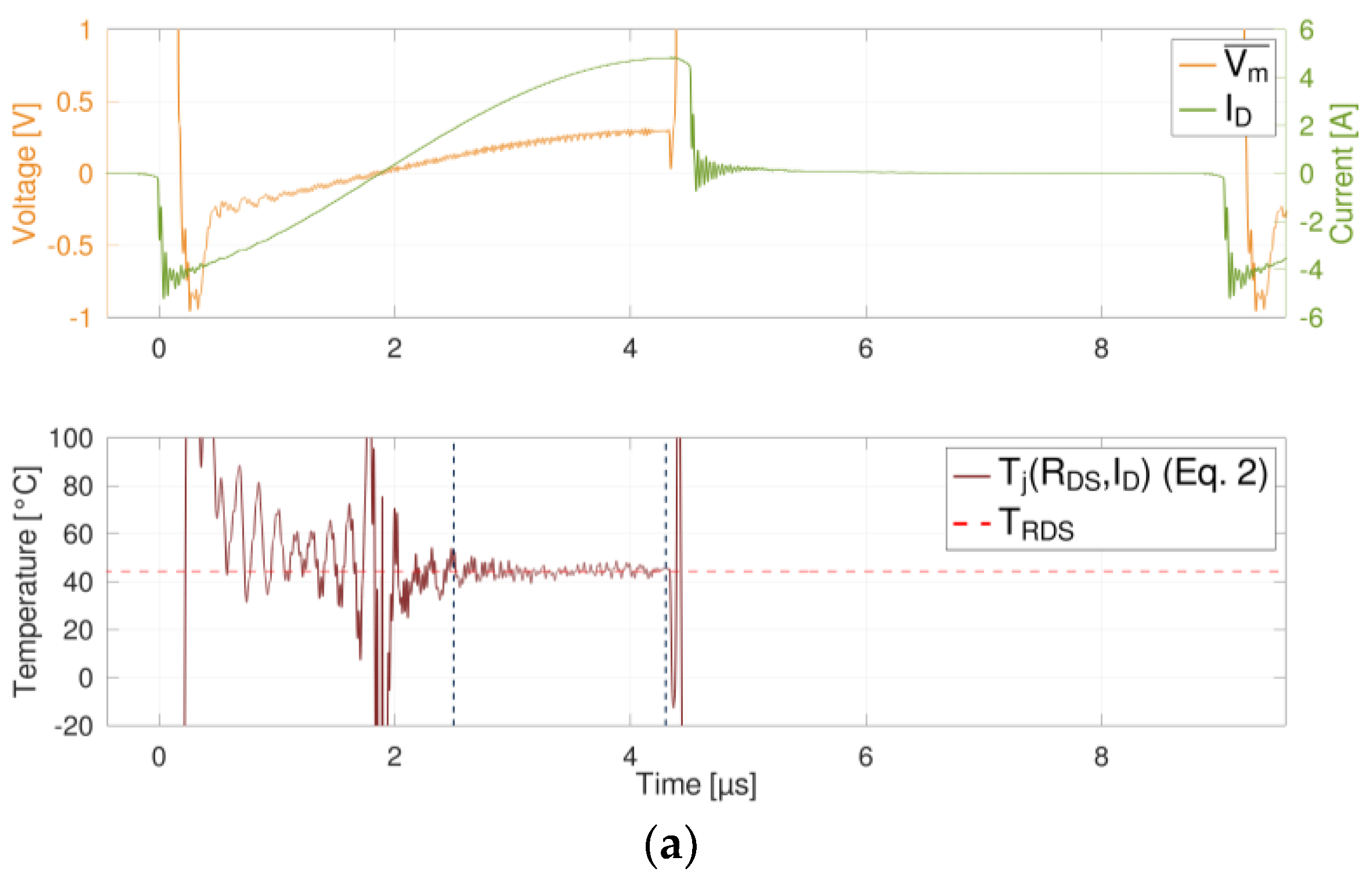


| Actual Temperature (°C) | Maximum Error (°C) | Current at which the Maximum Error Occurs (A) |
|---|---|---|
| 25.5 | 0.14 | 4.6 |
| 35.6 | 1.03 | 20 |
| 50.7 | 1.5 | 1.3 |
| 70.9 | 0.7 | 9.8 |
| 92.8 | 1.37 | 2.8 |
| 120.7 | 0.67 | 6.6 |
| Devices | Part Number | Description | Parameter | Value |
|---|---|---|---|---|
| D1, D2 | RFU02VSM6STR | Super fast recovery diode | Repetitive peak reverse voltage | 600 V |
| Average current | 0.2 A | |||
| Typ. Forward voltage | 1.5 V | |||
| Capacitance at VR = 0 | 5 pF | |||
| DN | RF05VAM2STR | Super fast recovery diode | Repetitive peak reverse voltage | 200 V |
| Average current | 0.5 A | |||
| Typ. Forward voltage | 0.85 V | |||
| Capacitance at VR = 0l | 25 pF | |||
| U1 | NCR420U | LED/diode driver | Maximum enable voltage | 40 V |
| Typ. stabilized output current | 10 mA | |||
| U2 | THS4631D | High-voltage, high slew rate, wideband Operational Amplifier | Unity gain bandwidth | 325 MHz |
| Slew rate | 900 V/µs | |||
| Max. supply voltage | 33 V | |||
| Max. Input Bias Current | 100 pA | |||
| Input Voltage Noise | 7 nV/√Hz | |||
| Input Offset Voltage | 500 µV | |||
| U3 | PESE1-S5-D12-M-TR | Isolated dual-output DC-DC converter | Input voltage | 5 V |
| Output voltage | ±12 V | |||
| Max. output current | ±42 mA | |||
| Max. output power | 1 W | |||
| Q1–4 | 2N7002 | N-channel MOSFET | Max. Drain—Source Voltage | 60 V |
| Max. continuous Drain current | 200 mA | |||
| Typ. Gate threshold voltage | 2.1 V | |||
| Typ. Turn-On time | 20 ns | |||
| Typ. Turn-Off time | 15 ns | |||
| R1–4 | Resistors | Resistance | 1 kΩ | |
| C1 | Capacitor | Capacitance | 5 pF |
Disclaimer/Publisher’s Note: The statements, opinions and data contained in all publications are solely those of the individual author(s) and contributor(s) and not of MDPI and/or the editor(s). MDPI and/or the editor(s) disclaim responsibility for any injury to people or property resulting from any ideas, methods, instructions or products referred to in the content. |
© 2024 by the authors. Licensee MDPI, Basel, Switzerland. This article is an open access article distributed under the terms and conditions of the Creative Commons Attribution (CC BY) license (https://creativecommons.org/licenses/by/4.0/).
Share and Cite
Ventimiglia, M.; Scuto, A.; Sorrentino, G.; Belverde, G.; Iannuzzo, F.; Rizzo, S.A. On-State Voltage Measurement Circuit for Condition Monitoring of MOSFETs in Resonant Converters. Electronics 2024, 13, 3902. https://doi.org/10.3390/electronics13193902
Ventimiglia M, Scuto A, Sorrentino G, Belverde G, Iannuzzo F, Rizzo SA. On-State Voltage Measurement Circuit for Condition Monitoring of MOSFETs in Resonant Converters. Electronics. 2024; 13(19):3902. https://doi.org/10.3390/electronics13193902
Chicago/Turabian StyleVentimiglia, Marco, Alfio Scuto, Giuseppe Sorrentino, Gaetano Belverde, Francesco Iannuzzo, and Santi Agatino Rizzo. 2024. "On-State Voltage Measurement Circuit for Condition Monitoring of MOSFETs in Resonant Converters" Electronics 13, no. 19: 3902. https://doi.org/10.3390/electronics13193902







